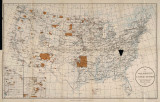| OCR Text |
Show 1 : 12 ' REPORT OF THE COMMISSIONER OF INDIAN APEAIRS. all. An approprialion of $25,000 made at the last session of Congress will permit of an addition which will provide room for all those in need of immediate care and treatment, includ~ng the transfer of those from the state institutions where formal requests have been made. The office will also be able to provide wards for the special I treatment of cases of acute insanity and quarters for patients suffer-ing from tuberculosis. SUPPRESSION OF ZIQUOR TRAFFIC. An appropriation of $60,000 was available for the suppression of the liquor traffic among the Indians during the fiscal year. The original appropriation of $50,000 was increased by an additional $10,000 for the fiscal year 1911, which was made immediately avail-able. As a result of this increased appropriation unusually extensive operations were conducted covering practically every State of the Union in which Indians resided. During the year 1,657 new cases were placed on the dockeh, 1,657 arrests were made, 747 indictments secured, and 1,055 convictdons obtained. Cases against 280 persons were dismissed and 23 persons were acquitted. Special attention has been given to the sale of liquor to Indians in Minnesota. In August the superintendent of the White Earth Reservation served formal notice on all the saloon keepers in the villages of the White Earth Reservation to close their places within thirty days. After the thirty days had expired, Chief Special Officer Johnson and his deputies closed the saloons in Mahnomen, Waukan, and Calloway and destroyed about 1,300 gallons of whisky, for which he and the nine deputies were imprisoned by the local authori-ties, but were released on a writ of habeas corpus by the United States court. On September 17 the chief special officer sent out a circular calling attention to article 7 of the treaty with the Chippewa Indians of February 22,1855, saying that thirty days after date the provisions of that section would be enforced within that part of Cass County lying above township 138. This closed about 25 saloons. On No-vember 25, 1909, and January 15 and April 8, 1910, more circulars were issued extending the closed territory, to which the provisions of the treaty of February 22, 1855, and October 2, 1863, would apply. The following counties or parts of counties in Minnesota were affected: Norman, Mahnomen, Clewwater, Beltrami, Itasca, Crow Wing, Cass, Wadena, Ottertail, Clay, Becker, Hubhard, Polk, and Red Lake. . About 100 saloons have been closed in this section, many gallons of whisky destroyed,' and many convictions secured. This vigorous action has had great deterrent effect. |




















































































































































































